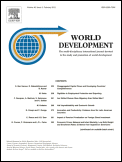Yes, it does.
At least, that is my answer to the question in a new article of mine titled “As You Sow, So Shall You Reap: The Welfare Impacts of Contract Farming,” which is forthcoming in World Development.
More specifically, I try to estimate the causal impacts of participation in contract farming — the economic institution in which a processing firm contracts its production of agricultural commodities out to grower households, or the first link in an agricultural value chain — on the welfare of the smallholders.
The major difficulty with studying such problems is that households are not randomly assigned to the treatment (i.e., participants in contract farming) and control (i.e., nonparticipants in contract farming) groups.
The smallholders who choose to participate in agricultural value chains do so following systematic patterns. The problem is that the researcher has no idea what those patterns are, as they often involve variables that are unobserved.
For example, it could be that more entrepreneurial smallholders are less likely to participate in agricultural value chains because they have better options. Or it could be that smallholders who are risk-averse are more likely to participate in agricultural value chains because contract farming partially insures them against income risk. But if it is difficult to measure risk aversion, it is even more difficult to measure entrepreneurial ability.
